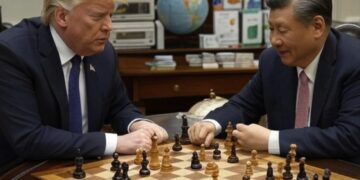The conflict, which began escalating during the first Trump administration, has now exploded with President Donald Trump’s “Liberation Day” tariffs—a staggering 104% duty on all Chinese goods, aimed at slashing the U.S. trade deficit and addressing long-standing grievances over intellectual property theft and fentanyl trafficking. In a sharp countermeasure, China announced today at noon Eastern that it would raise its tariffs on all U.S. imports from 34% to 84%, a dramatic escalation that directly mirrors the U.S.’s aggressive posture. This move threatens to further disrupt a bilateral trade relationship that saw $582.4 billion in goods exchanged in 2024, according to U.S. Census Bureau data.
The fallout for American stakeholders is severe. U.S. importers, shouldering 93% of tariff costs per a 2024 Peterson Institute study, are passing the burden onto consumers, driving up prices for everyday goods like electronics, clothing, and household items. The Tax Foundation has revised its estimates, now projecting a $2,200 annual cost per U.S. household—a $300 increase from earlier forecasts—due to the compounded effect of China’s new 84% tariffs. American farmers, particularly soybean and poultry producers, are among the hardest hit. With China sourcing 60% of its soybeans from the U.S. in 2023, the new tariffs have accelerated Beijing’s pivot to Brazil and Argentina, which have ramped up production to fill the gap. U.S. agricultural exports to China dropped by 18% in 2024, and experts predict a further 25% decline this year.
China, however, is not emerging unscathed. The nation’s economy, already grappling with a property sector crisis and declining consumer confidence, faces a steeper downturn. Citigroup has updated its 2025 GDP forecast for China, now anticipating a 2.8% decline, up from 2.4%, as the new tariffs exacerbate existing pressures. High-tech sectors, particularly semiconductors, are feeling the squeeze, with U.S. export controls on rare earth minerals—critical for tech manufacturing—adding to China’s woes. Beijing’s retaliatory measures, including export restrictions on gallium and germanium, are further disrupting global supply chains, impacting industries from electronics to renewable energy.
Globally, the ripple effects are profound. Allies like the EU and Japan, caught in the crossfire, have voiced alarm over the trade war’s impact on their economies. The EU recently approved counter-tariffs on U.S. goods, targeting products like whiskey and motorcycles, in a bid to pressure Washington into de-escalation. Stock markets worldwide are reeling, with the Dow Jones Industrial Average dropping 5% in the past week alone, and the Shanghai Composite Index falling 4.2%. Economists are increasingly warning of a looming global recession, with the International Monetary Fund projecting a 1.5% contraction in global trade volume for 2025. Businesses, from small manufacturers to multinational corporations, are pausing investments, awaiting clarity in this high-stakes showdown. As both superpowers dig in, the costs continue to mount—for consumers, farmers, exporters, and the global economy—with no clear resolution on the horizon.
The fallout for American stakeholders is severe. U.S. importers, shouldering 93% of tariff costs per a 2024 Peterson Institute study, are passing the burden onto consumers, driving up prices for everyday goods like electronics, clothing, and household items. The Tax Foundation has revised its estimates, now projecting a $2,200 annual cost per U.S. household—a $300 increase from earlier forecasts—due to the compounded effect of China’s new 84% tariffs. American farmers, particularly soybean and poultry producers, are among the hardest hit. With China sourcing 60% of its soybeans from the U.S. in 2023, the new tariffs have accelerated Beijing’s pivot to Brazil and Argentina, which have ramped up production to fill the gap. U.S. agricultural exports to China dropped by 18% in 2024, and experts predict a further 25% decline this year.
China, however, is not emerging unscathed. The nation’s economy, already grappling with a property sector crisis and declining consumer confidence, faces a steeper downturn. Citigroup has updated its 2025 GDP forecast for China, now anticipating a 2.8% decline, up from 2.4%, as the new tariffs exacerbate existing pressures. High-tech sectors, particularly semiconductors, are feeling the squeeze, with U.S. export controls on rare earth minerals—critical for tech manufacturing—adding to China’s woes. Beijing’s retaliatory measures, including export restrictions on gallium and germanium, are further disrupting global supply chains, impacting industries from electronics to renewable energy.
Globally, the ripple effects are profound. Allies like the EU and Japan, caught in the crossfire, have voiced alarm over the trade war’s impact on their economies. The EU recently approved counter-tariffs on U.S. goods, targeting products like whiskey and motorcycles, in a bid to pressure Washington into de-escalation. Stock markets worldwide are reeling, with the Dow Jones Industrial Average dropping 5% in the past week alone, and the Shanghai Composite Index falling 4.2%. Economists are increasingly warning of a looming global recession, with the International Monetary Fund projecting a 1.5% contraction in global trade volume for 2025. Businesses, from small manufacturers to multinational corporations, are pausing investments, awaiting clarity in this high-stakes showdown. As both superpowers dig in, the costs continue to mount—for consumers, farmers, exporters, and the global economy—with no clear resolution on the horizon.
ReplyForward |





































